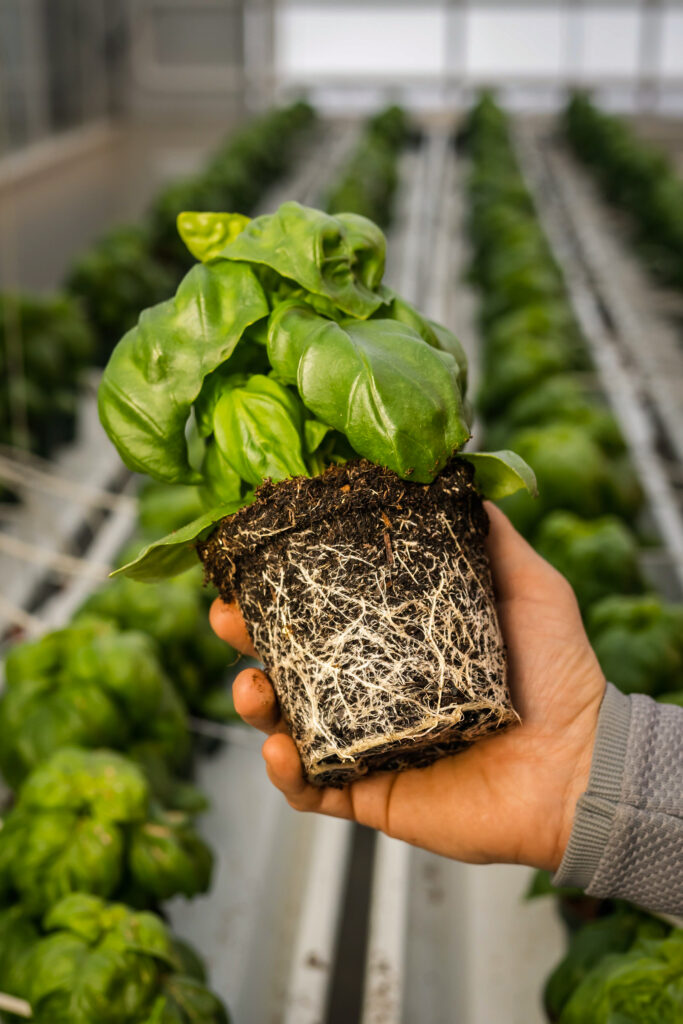Poinsettia Cultivation – Phase 6
By Brian Cantin, Senior Grower Advisor
Pinching poinsettias can often become so routine that one forgets several important prerequisites to the process :
- Always make sure that the plants have developed sufficient roots toward the outside of the potting media. Insufficient root development can cause the developing breaks to grow slowly or develop unevenly, reducing the number of viable breaks.
- It is important to control growth prior to pinching to keep the internodes short on the chassis of the pinched plant. Keeping internodes short fosters even bract height, with all the bracts above the green canopy. Controlling growth during propagation and pre-pinch will favour development of the desired stacked form of the plant chassis. Managing the distance between leaves, combined with a timely pinch, creates a saleable plant with all the bracts at the same level.
- The timing of the pinch has major ramifications on the quality of the finished plants. Allowing about seven to fourteen days with long light between pinching and the start of short days provides enough time for development of adequate shoot length and proper bract display. The vigour and growth habit of different cultivars will dictate whether to increase or decrease the number of long days after pinch and prior to the start of short days. The time between pinch and the start of short days greatly affects the final height and overall size of the plant.
Calculate the ideal moment to pinch relative to the start of short days so the desired number of leaves (appropriate for the pot size) have time to develop.
Two Pinching Techniques
Pinching techniques are described as a hard or soft pinch. A hard pinch involves removal of several leaves and the growing point. This type of pinch tends to produce rapid breaks of even length. Using this technique results in fewer problems with dominant shoots. A soft pinch, where only the growing tip is removed, tends to produce breaks more slowly due to the apical dominance effect of the immature leaves left on the established cutting. If for some reason a soft pinch is carried out, then leaves should also be removed to produce more uniform breaking action. The number of flowers per pot is dictated by how many nodes (leaves) are left on the stem after pinch. One must take into consideration that the lowest one or two nodes may not contribute to a full complement of bracts at the time of flowering. On the other hand, leaving too many nodes (i.e., more than 7 or 8) results in too many branches and stem breakage when the plants are sleeved and shipped.
Prevent after Pinch Stress
Stressful conditions before and after pinch – such as high temperatures, high light and low humidity – can be detrimental to the development of breaks. Misting the plants, providing shade and wetting down floors (if feasible in your greenhouses), are recommended to prevent post-pinch stress. Post-pinch fertilization coincides with a phase of rapid growth. In the past, poinsettias have been considered a high fertility crop. In my opinion, light-leaf cultivars do indeed fit into this category; however, the newer dark-leaf cultivars are very efficient in their utilization of nitrogen and require lower nutrient levels. Thus, in general, light-leaf varieties require more nitrogen than dark-leaf varieties. Success with poinsettias relies on raising the initial fertility quickly, then knowing when to taper the fertility towards the end of the crop. Each phase of growth will dictate the optimal ratio of nitrate-N to ammonium-N to achieve rapid vegetative growth, floral initiation and post-harvest quality. It is important to be pro-active and monitor pH and soluble salts on a regular basis to avoid jeopardizing the crop. Calcium and magnesium should be monitored by media analysis, because they are both very important nutrients in poinsettia production.
Temperature
The rate of poinsettia growth is primarily influenced by the average daily temperature. Modulating temperature can be used to determine the number of leaves unfolded per week, providing a better idea of how many leaves will unfold overall and the corresponding number of internodes that will become part of your height control program. When feasible, try to keep night temperatures in the low 70’s until three weeks after pinch. This creates sturdy, compact growth with stronger branches.
Growth Regulators
Monitoring and managing leaf internode length should begin immediately after pinch. Allowing the first and second internodes to stretch will result in weaker stems and will jeopardize achieving the overall height you were targeting for a saleable plant. There are many PGR products available and my only advice at this time is to read the label properly, including proper application methods and any precautionary notes on phytotoxicity and environmental conditions that can reduce product performance.
Good quality poinsettias demand detailed attention to growing conditions over a long period of time. You owe it to yourself and to the consumer to ensure good postproduction longevity. After all, a happy customer is a return customer.
–


